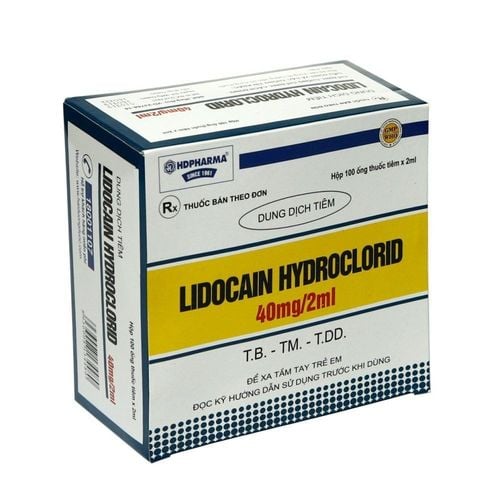This is an automatically translated article.
Corphedra is a prescription drug, indicated in cases where the patient has hypotension during surgical anesthesia. To ensure the effectiveness of using Corphedra, patients need to follow the instructions of a specialist, and refer to the information in the article below.
1. What is the use of Corphedra?
1.1. What is Corphedra? Corphedra belongs to the group of vasoconstrictor drugs, is an exclusive registered product of Par Pharmaceutical, Inc. With the main ingredient is ephedrine sulfate.
The drug is produced as a solution for injection in a clear glass vial of 1 ml single dose containing 50mg/mL ephedrine sulfate, equivalent to 38mg ephedrine base.
Corphedra is recommended for use by adults.
1.2. What are the uses of Corphedra? Corphedra is an injectable drug that is indicated for the treatment of hypotension during surgery due to spinal anesthesia or epidural anesthesia.
Note: The use of Corphedra for the treatment of acute bronchospasm, Stokes-Adams syndrome (i.e. paralysis/syncope) with complete heart block, narcolepsy, depression, or myasthenia gravis has been discontinued. preferred because there are other more effective methods.
Corphedra is contraindicated in the following cases:
Patients with hypersensitivity to sympathomimetic amines and patients with angle-closure glaucoma. Patients are anesthetized with drugs such as Cyclopropane or Halothane because they can make the heart more sensitive. People with contraindications to vasopressors, eg thyrotoxicosis, diabetes, obstetrics when maternal blood pressure exceeds 130/80, hypertension and other cardiovascular disorders.
2. How to use the drug Corphedra
2.1. How to use the drug Corphedra The drug is used by injection, intravenous infusion. Corphedra (Corphedra injection) must be diluted prior to administration as an intravenous drug to achieve the desired concentration. Dilute with 0.9% physiological saline solution or 5% dextrose solution. Visually inspect the medication for cloudiness, discoloration or precipitation before use. Intravenous dose preparation: Withdraw 50mg (1ml) of Corphedra and dilute with 9ml of 5% Dextrose solution or 0.9% Sodium Chloride solution. Withdraw an appropriate dose of the 5 mg/mL solution prior to intravenous administration. 2.2. Dosage of Corphedra Dosage is adjusted according to blood pressure target (ie, titrated to effect). The recommended starting dose is 5 to 10 mg IV. Take additional doses as needed, not to exceed a total dose of 50 mg. Treatment when missed dose:
Corphedra is administered by medical staff, so it will limit the missed dose. Treatment of Overdose:
Overdosing on Corphedra can cause an excessive increase in blood pressure. In case of overdose, blood pressure should be carefully monitored. If blood pressure continues to rise to unacceptable levels, parenteral antihypertensive medications may be used as directed by your doctor.
3. Notes when taking Corphedra
Severe postpartum hypertension has been described in patients receiving both vasopressors (eg, methoxamine, phenylephrine, ephedrine) and oxytocin (ie, methylergonovine, ergonovine). Some of these patients had a stroke. Carefully monitor the blood pressure of people who have received both Corphedra and oxytocin injections. It is documented that repeated use of Corphedra can lead to dizziness or anaphylaxis. Attention should be paid to the treatment of anaesthesia-induced hypertension with the potential for arrhythmias and an alternative approach should be prepared to minimize undesirable effects. When used to prevent hypotension, Corphedra was associated with an increased incidence of hypertension compared with when ephedrine was used to treat hypotension. Dose selection for elderly patients should be cautious, usually starting at the lowest dose range, reflecting the frequency of impaired hepatic, renal or cardiac function, and comorbidities or other drug therapy. Corphedra is eliminated primarily by the kidneys, and the risk of side effects may be higher in patients with impaired renal function. Because elderly patients are more likely to have impaired renal function, care should be taken in dose selection and frequent monitoring of renal function. Ephedrine and its metabolites are excreted in the urine. In patients with renal insufficiency, Corphedra is likely to be eliminated with a correspondingly increased half-life, resulting in a slower elimination of ephedrine and thus prolongation of its pharmacological effects and possible adverse effects. Carefully monitor patients with renal impairment after the initial dose for adverse effects. Do not use Corphedra for pregnant women, nursing mothers and young children.
4. Side effects of the drug Corphedra
Take large doses of Corphedra most patients will feel.
Digestive disorders: Nausea, vomiting, loss of appetite. Cardiac Disorders: Tachycardia, palpitations, palpitations, reactive hypertension, bradycardia, ventricular extrasystoles, RR changes. Nervous system disorders: Dizziness. Psychiatric disorders: Restlessness. Urinary system disorders: Sphincter spasm leads to difficulty and pain in urination. Urinary retention can develop in men with pseudogout. If you experience these symptoms, you need to stop using Corphedra and notify your doctor for appropriate treatment.
5. Corphedra drug interactions
Clonidine, propofol, monoamine oxidase inhibitors (MAOIs), Atropine... These drugs increase the squeezing effect of the active ingredient Ephedrin. α-adrenergic antagonists, P-adrenergic receptor antagonists, Reserpine, Quinidine, Mephentermine antagonize the compressive effect of ephedrine. Ephedrine can inhibit guanethidine-induced neuronal blockade, nullifying its antihypertensive effect. Physicians should monitor patients for blood pressure response and adjust dosage or pressure selection accordingly. Ephedrine may reduce the time to onset of neuromuscular blockade when used for intubation with rocurorone, if used concurrently for anesthesia. Ephedrine may reduce the effectiveness of epidural block by accelerating the regression of analgesia. Concurrent use of Corphedra with Theophylline may increase the frequency of nausea, nervousness, and insomnia. Using Corphedra with a cardiac glycoside, such as Digitalis, may increase the chance of an arrhythmia.
6. How to store the drug Corphedra
Storage period for Corphedra is 36 months from the date of manufacture. Storage temperature of the drug is from 20 to 25 degrees Celsius or at room temperature from 15 to 30 degrees Celsius. Store Corphedra in its original packaging, protected from light. directly and avoid moisture. Each Corphedra potion is for one-time use only, the rest are discarded. Keep Corphedra out of the reach of children. Above is all information about the drug Corphedra, patients need to carefully read the instructions for use, consult a doctor / pharmacist before using. Note, Corphedra is a prescription drug, patients need to use the drug as prescribed by the doctor, absolutely do not self-treat at home.













